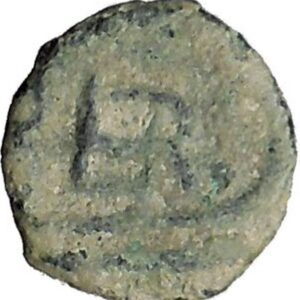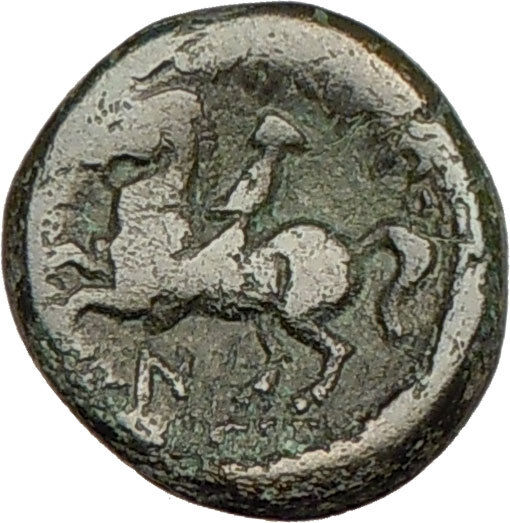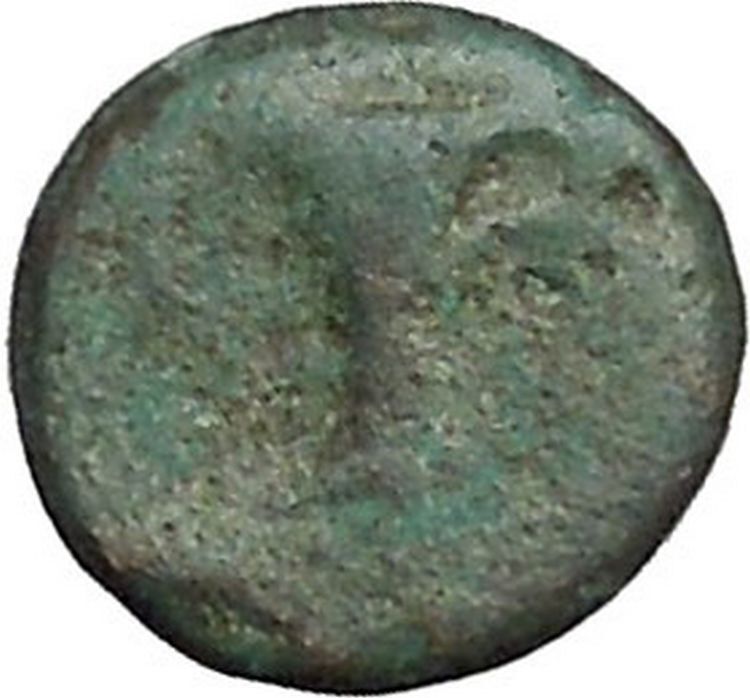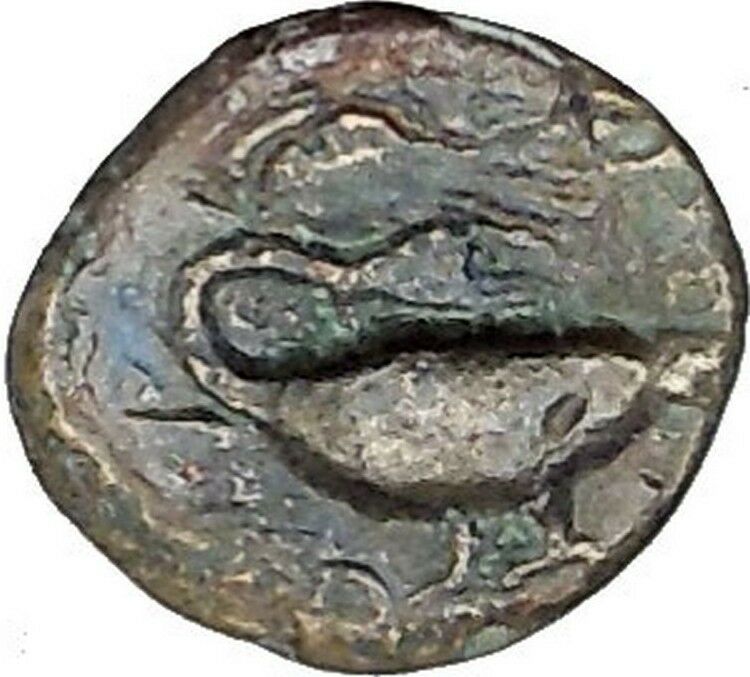|
Greek city of Himera in Sicily
Bronze Hemilitron 15mm (2.37 grams) Struck 420-408 B.C.
Reference: Sear 1110; B.M.C. 2.54
Head of nymph Himera left, wearing sphendone; six pellets before.
Six pellets within laurel-wreath.
You are bidding on the exact item pictured,
provided with a Certificate of Authenticity and Lifetime Guarantee of
Authenticity.
A laurel wreath is a circular
wreath
made of interlocking branches and leaves
of the
bay laurel
(Laurus nobilis), an aromatic
broadleaf evergreen, or later from spineless butcher’s broom (Ruscus
hypoglossum) or cherry laurel (Prunus
laurocerasus). In
Greek mythology
,
Apollo
is represented wearing a laurel wreath
on his head. In
ancient Greece
wreaths were awarded to victors,
both in athletic competitions, including the ancient
Olympics
made of wild olive-tree known as “kotinos“
(κότινος),[1]
(sc. at
Olympia
) and in poetic meets; in
Rome
they were symbols of martial victory,
crowning a successful commander during his
triumph
. Whereas ancient laurel wreaths are
most often depicted as a
horseshoe
shape, modern versions are usually
complete rings.
In common modern idiomatic
usage it refers to a victory. The
expression “resting on one’s laurels” refers to someone relying entirely on
long-past successes for continued fame or recognition, where to “look to one’s
laurels” means to be careful of losing rank to competition.
Academic use
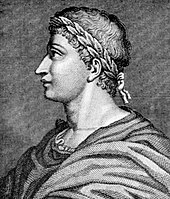
Ovid
with laurel wreath, common in
poets.
In some countries the laurel wreath is used as symbol of the
master’s degree
. The wreath is given to young
masters in the
graduation ceremony
of the university. The word
“Laureate”
in ‘poet
laureate‘ refers to being signified by the laurel wreath. The
medieval Florentine poet and philosopher
Dante Alighieri
,[dubious
–
discuss
] a graduate of the
Sicilian School
, is often represented in
paintings and sculpture wearing a laurel wreath.
Laureato[3]
is the term used in Italy
to refer to any graduated student. In
some italian regions (Veneto,
Friuli-Venezia Giulia
and
Trentino
), right after the graduation ceremony
(in Italian: laurea), the student receives a laurel wreath and is allowed
to wear it for the rest of the day. This tradition was born in the
University of Padua
and since the end of the
19th century is common to all
northeastern Italian
universities.
At
Connecticut College
in the United States,
members of the junior class carry a laurel
chain
, which the seniors pass through during
commencement. It represents nature and the continuation of life from year to
year. Immediately following commencement, the junior girls write out with the
laurels their class year, symbolizing they have officially become seniors and
the cycle will repeat itself the following spring.
At
Mount Holyoke College
in
South Hadley, Massachusetts
, United States,
laurel has been a fixture of
commencement
traditions since 1900, when
graduating students carried or wore laurel wreaths. In 1902, the chain of
mountain laurel
was introduced; since then,
tradition has been for seniors to march across campus, carrying and linked by
the chain. The mountain laurel represents the
bay laurel
used by the
Romans
in wreaths and crowns of honor.[4]
At Reed College
in
Portland, Oregon
, United States, members of the
senior class receive laurel wreaths upon submitting their senior
thesis
in May. The tradition stems from the use
of laurel wreaths in athletic competitions; the seniors have “crossed the finish
line,” so to speak.
At
St. Mark’s School
in
Southborough, Massachusetts
, students who
successfully complete three years of one classical language and two of the other
earn the distinction of the Classics Diploma and the honor of wearing a laurel
wreath on Prize Day.
In Sweden
, those receiving a Doctorate or an
Honorary Doctorate
at the Faculty of Philosophy
(meaning Philosophy, Languages, Arts, History and Social Sciences), receive a
laurel wreath during the ceremony of conferral of the degree.
Architectural and decorative arts motif

“Victory, A Knight Being Crowned With A Laurel Wreath” by
Frank Dicksee
.
The laurel wreath is a common motif in
architecture
,
furniture
, and
textiles
. The laurel wreath is seen carved in
the stone and decorative plaster works of
Robert Adam
, and in
Federal
,
Regency
,
Directoire
, and
Beaux-Arts
periods of architecture. In
decorative arts, especially during the
Empire period
, the laurel wreath is seen woven
in textiles, inlaid in marquetry, and applied to furniture in the form of gilded
brass mounts.
Alfa Romeo
added a laurel wreath to their
logo after they won the inaugural Automobile World Championship in
1925 with the
P2
racing car.
A nymph in
Greek mythology
is a female minor nature deity
typically associated with a particular location or landform. Different from
gods, nymphs are generally regarded as divine spirits who animate nature, and
are usually depicted as beautiful, young
nubile
maidens who love to dance and sing;
their amorous freedom sets them apart from the restricted and chaste wives and
daughters of the Greek
polis
. They are believed to dwell in
mountains and
groves
, by springs and rivers, and also in
trees and in valleys and cool
grottoes
. Although they would never die of old
age nor illness, and could give birth to fully immortal children if mated to a
god, they themselves were not necessarily immortal, and could be beholden to
death in various forms. Charybdis and Scylla were once nymphs.
Other nymphs, always in the shape of young maidens, were part of the
retinue
of a god, such as
Dionysus
,
Hermes
, or
Pan
, or a goddess, generally the huntress
Artemis
. Nymphs were the frequent target of
satyrs
. They are frequently associated with the
superior divinities: the huntress
Artemis
; the prophetic
Apollo
; the reveller and god of
wine,
Dionysus
; and rustic gods such as Pan and
Hermes.
Etymology
Nymphs are personifications of the creative and fostering activities of
nature, most often identified with the life-giving outflow of springs: as
Walter Burkert
(Burkert 1985:III.3.3) remarks,
“The idea that rivers are gods and springs divine nymphs is deeply rooted not
only in poetry but in belief and ritual; the worship of these deities is limited
only by the fact that they are inseparably identified with a specific locality.”
The
Greek
word
νύμφη has “bride” and “veiled” among its meanings: hence a marriageable
young woman. Other readers refer the word (and also
Latin
nubere and
German
Knospe) to a root expressing the
idea of “swelling” (according to
Hesychius
, one of the meanings of
νύμφη is “rose-bud”).
A laurel wreath
is a circular wreath
made of interlocking branches and leaves
of the
bay laurel
(Laurus nobilis,
Lauraceae
), an aromatic broadleaf evergreen. In
Greek mythology
,
Apollo
is represented wearing a laurel wreath
on his head. In
ancient Greece
wreaths were awarded to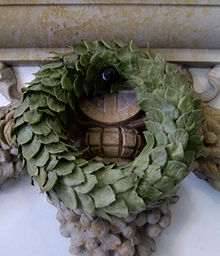
victors, both in athletic competitions, including the ancient
Olympics
made of wild olive-tree known as “kotinos“
(κότινος), (sc. at
Olympia
) and in poetic meets; in
Rome
they were symbols of martial victory,
crowning a successful commander during his
triumph
. Whereas ancient laurel wreaths are
most often depicted as a
horseshoe
shape, modern versions are usually
complete rings.
In common modern idiomatic
usage it refers to a victory. The
expression “resting on one’s laurels” refers to someone relying entirely on
long-past successes for continued fame or recognition, where to “look to one’s
laurels” encourages an individual to take inspiration from past achievements to
conquer a fresh task.
Himera (Greek:
Ἱμέρα), was an important
ancient Greek
city of
Sicily
,
situated on the north coast of the island, at the mouth of the river of the same
name (the modern
Grande
), between Panormus (modern
Palermo
) and
Cephaloedium (modern
Cefalù
). Its
remains lie within the borders of the modern
comune
of
Termini Imerese
.


Remains of the Temple of Victory.
Ideal reconstruction of the Temple of Victory.
//
History
Foundation
and earliest history
It was the first Greek settlement on this part of the island and was a
strategic outpost just outside the eastern boundary of the
Carthaginian
-controlled west.
Thucydides
says it was the only Greek city on this coast of Sicily,[1]
which must however be understood with reference only to independent cities;
Mylae
, which was also on the north coast, and certainly of Greek origin,
being a dependency of
Zancle
(modern
Messina
). All
authorities agree that Himera was a colony of Zancle, but Thucydides tells us
that, with the emigrants from Zancle, who were of Chalcidic origin, were mingled
a number of
Syracusan
exiles, the consequence of which was, that, though the
institutions (νόμιμα) of the new city
were Chalcidic, its dialect had a mixture of
Doric
.
The foundation of Himera is placed subsequent to that of Mylae (as, from
their relative positions, might naturally have been expected) both by
Strabo
and
Scymnus Chius
:
its date is not mentioned by Thucydides, but
Diodorus
tells us that it had existed 240 years at the time of its
destruction by the Carthaginians, which would fix its first settlement in
648 BCE
.[2]
We have very little information as to its early history: an obscure notice in
Aristotle
,[3]
from which it appears to have at one time fallen under the dominion of the
tyrant Phalaris
,
being the only mention we find of it, until about
490 BCE
,
when it afforded a temporary refuge to
Scythes
,
tyrant of Zancle, after his expulsion from the latter city.[4]
Not long after this event, Himera fell itself under the yoke of a despot named
Terillus
,
who sought to fortify his power by contracting a close alliance with
Anaxilas
,
at that time ruler both of Rhegium (modern
Reggio di Calabria
) and Zancle. But Terillus was unable to resist the power
of
Theron
,
despot of Agrigentum (modern
Agrigento
),
and, being expelled by him from Himera, had recourse to the assistance of the
Carthaginians, a circumstance which became the immediate occasion of the first
great expedition of that people to Sicily,
480 BCE
.[5]
First
interaction with Carthage
The magnitude of the armament sent under
Hamilcar
,
who is said to have landed in Sicily with an army of 300,000 men, in itself
sufficiently proves that the conquest of Himera was rather the pretext, than the
object, of the war: but it is likely that the growing power of that city, in the
immediate neighborhood of the Carthaginian settlements of Panormus and
Solus
, had already given umbrage to the latter people. Hence it was against
Himera that the first efforts of Hamilcar were directed: but Theron, who had
thrown himself into the city with all the forces at his command, was able to
maintain its defence till the arrival of
Gelon of Syracuse
, who, notwithstanding the numerical inferiority of his
forces, defeated the vast army of the Carthaginians with such slaughter that the
Battle of Himera
was regarded by the Greeks of Sicily as worthy of
comparison with the contemporary victory of
Salamis
.[6]
The same feeling probably gave rise to the tradition or belief, that both
triumphs were achieved on the very same day.[7]
After
the Battle of Himera
This great victory left Theron in the undisputed possession of the
sovereignty of Himera, as well as of that of Agrigentum; but he appears to have
bestowed his principal attention upon the latter city, and consigned the
government of Himera to his son
Thrasydaeus
. But the young man, by his violent and oppressive rule, soon
alienated the minds of the citizens, who in consequence applied for relief to
Hieron of Syracuse
, at that time on terms of hostility with Theron. The
Syracusan despot, however, instead of lending assistance to the discontented
party at Himera, betrayed their overtures to Theron, who took signal vengeance
on the unfortunate Himeraeans, putting to death a large number of the
disaffected citizens, and driving others into exile.[8]
Shortly after, seeing that the city had suffered greatly from these severities,
and that its population was much diminished, he sought to restore its prosperity
by establishing there a new body of citizens, whom he collected from various
quarters. The greater part of these new colonists were of
Dorian
extraction; and though the two bodies of citizens were blended into one, and
continued to live harmoniously together, we find that from this period Himera
became a Doric city, and both adopted the institutions, and followed the policy,
of the other Doric states of Sicily.[9]
This settlement seems to have taken place in
476 BCE
,[10]
and Himera continued subject to Theron till his death, in
472 BCE
: but Thrasydaeus retained possession of the sovereignty for a very
short time after the death of his father, and his defeat by Hieron of Syracuse
was speedily followed by his expulsion both from Agrigentum and Himera.[11]
In
466 BCE
we find the Himeraeans, in their turn, sending a force to assist the
Syracusans in throwing off the yoke of
Thrasybulus
; and, in the general settlement of affairs which followed soon
after, the exiles were allowed to return to Himera, where they appear to have
settled quietly together with the new citizens.
[12]
From
this period Diodorus expressly tells us that Himera was fortunate enough to
escape from civil dissensions,[13]
and this good government must have secured to it no small share of the
prosperity which was enjoyed by the Sicilian cities in general during the
succeeding half-century.
But though we are told in general terms that the period which elapsed from
this re-settlement of Himera till its destruction by the Carthaginians (461–408
BCE), was one of peace and prosperity, the only notices we find of the city
during this interval refer to the part it took at the time of the
Athenian
expedition to Sicily,
415 BCE
. On that occasion, the Himeraeans were among the first to promise
their support to Syracuse: hence, when
Nicias
presented himself before their port with the Athenian fleet, they altogether
refused to receive him; and, shortly after, it was at Himera that
Gylippus
landed, and from whence he marched across the island to Syracuse, at the head of
a force composed in great part of Himeraean citizens.[14]
Destruction
by Carthage
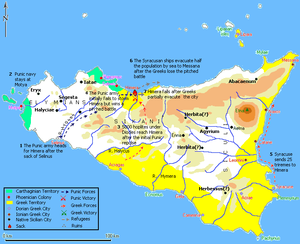
A few years after this the prosperity of the city was brought to a sudden and
abrupt termination by the great Carthaginian expedition to Sicily,
408 BCE
. Though the ostensible object of that armament, as it had been of
the Athenian, was the support of the
Segestans
against their neighbors, the
Selinuntines
,
yet there can be no doubt that the Carthaginians, from the first, entertained
more extensive designs; and, immediately after the destruction of Selinus,
Hannibal Mago
, who commanded the expedition, hastened to turn his arms
against Himera. That city was ill-prepared for defence; its fortifications were
of little strength, but the citizens made a desperate resistance, and by a
vigorous sally inflicted severe loss on the Carthaginians. They were at first
supported by a force of about 4000 auxiliaries from Syracuse, under the command
of
Diocles
; but that general became seized with a panic fear for the safety of
Syracuse itself, and precipitately abandoned Himera, leaving the unfortunate
citizens to contend singlehanded against the Carthaginian power. The result
could not be doubtful, and the city was soon taken by storm: a large part of the
citizens were put to the sword, and not less than 3000 of them, who had been
taken prisoners, were put to death in cold blood by Hannibal, as a sacrifice to
the memory of his grandfather Hamilcar.[15]
The city itself was utterly destroyed, its buildings razed to the ground, and
even the temples themselves were not spared; the Carthaginian general being
evidently desirous to obliterate all trace of a city whose name was associated
with the great defeat of his countrymen.
Diodorus, who relates the total destruction of Himera, tells us expressly
that it was never rebuilt, and that the site remained uninhabited down to his
own times.[16]
It seems at first in contradiction with this statement, that he elsewhere
includes the Himeraeans, as well as the Selinuntines and Agrigentines, among the
exiled citizens that were allowed by the treaty, concluded with Carthage, in
405 BCE
, to return to their homes, and inhabit their own cities, on
condition of paying tribute to Carthage and not restoring their fortifications.
[17]
And it
seems clear that many of them at least availed themselves of this permission, as
we find the Himeraeans subsequently mentioned among the states that declared in
favour of
Dionysius I of Syracuse
, at the commencement of his great war with Carthage
in
397 BCE
; though they quickly returned to the Carthaginian alliance in the
following year.[18]
The explanation of this difficulty is furnished by
Cicero
, who
tells us that, after the destruction of Himera, those citizens who had survived
the calamity of the war established themselves at
Thermae
, within
the confines of the same territory, and not far from their old town.[19]
Diodorus gives a somewhat different account of the foundation of Thermae, which
he represents as established by the Carthaginians themselves before the close of
the war, in
407 BCE
.[20]
But it is probable that both statements are substantially correct, and that the
Carthaginians founded the new town in the immediate neighbourhood of Himera, in
order to prevent the old site being again occupied; while the Himeraean exiles,
when they returned thither, though they settled in the new town, naturally
regarded themselves as still the same people, and would continue to bear the
name of Himeraeans. How completely, even at a much later period, the one city
was regarded as the representative of the other, appears from the statement of
Cicero, that when
Scipio Africanus
, after the capture of Carthage, restored to the
Agrigentines and Gelenses the statues that had been carried off from their
respective cities, he at the same time restored to the citizens of Thermae those
that had been taken from Himera.[21]
Hence we cannot be surprised to find that, not only are the Himeraeans still
spoken of as an existing people, but even that the name of Himera itself is
sometimes inadvertently used as that of their city. Thus, in
314 BCE
, Diodorus tells us that, by the treaty between
Agathocles
and the Carthaginians, it was stipulated that
Heracleia
, Selinus, and Himera should continue subject to Carthage as they
had been before.
[22]
It is
much more strange that we find the name of Himera reappear both in
Mela and
Pliny
, though we
know from the distinct statements of Cicero and Strabo, as well as Diodorus,
that it had ceased to exist centuries before.[23]
Foundation
of Thermae
Main article:
Termini Imerese
The new town of Thermae or Therma called for the sake of distinction Thermae
Himerenses,[24]
which thus took the place of Himera, obviously derived its name from the hot
springs for which it was celebrated, and the first discovery of which was
connected by legends with the wanderings of
Hercules
.[25]
It appears to have early become a considerable town, though it continued, with
few and brief exceptions, to be subject to the Carthaginian rule. In the
First Punic War its
name is repeatedly mentioned. Thus, in
260 BCE
, a body of
Roman
troops were encamped in the neighborhood, when they were attacked by
Hamilcar
,
and defeated with heavy loss.[26]
Before the close of the war, Thermae itself was besieged and taken by the
Romans.[27]
Cicero relates that the Roman government restored to the Thermitani their city
and territory, with the free use of their own laws, as a reward for their steady
fidelity.
[28]
They
were on hostile terms with Rome during the First Punic War, so it can only be to
the subsequent period that these expressions apply; but the occasion to which
they refer is unknown. In the time of Cicero, Thermae appears to have been a
flourishing place, carrying on a considerable amount of trade, though the orator
speaks, of it as oppidum non maximum.[29]
It seems to have received a
colony
in
the time of Augustus
, whence we find mention in inscriptions of the Ordo et Populus
splendidissimae Coloniae Augustae Himeraeorum Thermitanorum:
[30]
and
there can be little doubt that the Thermae colonia of
Pliny
in reality
refers to this town, though he evidently understood it to be Thermae Selinuntiae
(modern Sciacca
),
as he places it on the south coast between Agrigentum and Selinus.
[31]
There
is little subsequent account of Thermae; but, as its name is found in
Ptolemy
and
the Itineraries, it appears to have continued in existence throughout the period
of the Roman Empire
, and probably never ceased to be inhabited, as the modern town
of
Termini Imerese
retains the ancient site as well as name.[32]
The magnificence of the ancient city, and the taste of its citizens for the
encouragement of art, are attested by Cicero, who calls it in primis Siciliae
clarum et ornatum; and some evidence of it remained, even in the days of
that orator, in the statues preserved by the Thermitani, to whom they had been
restored by Scipio, after the conquest of Carthage; and which were valuable, not
only as relics of the past, but from their high merit as works of art.[33]
The numerous examples of coins from Himera testify to the city’s wealth in
antiquity.
Current
situation
Because of extensive remains, no doubt can therefore exist with regard to the
site of Thermae, which would be, indeed, sufficiently marked by the hot springs
themselves; but the exact position of the more ancient city of Himera was a
subject of controversy until recent times. The opinion of
Cluverius
, which has been followed by almost all subsequent writers into the
19th century, would place it on the left bank of the river which flows by
Termini on the west, and is thence commonly known as the Fiume di Termini,
though called in the upper part of its course Fiume San Leonardo. On this
supposition the inhabitants merely removed from one bank of the river to the
other; and this would readily explain the passages in which Himera and Thermae
appear to be regarded as identical, and where the river Himera (which
unquestionably gave name to the older city) is represented at the same time as
flowing by Thermae.[34]
On the other hand, there is great difficulty in supposing that the Fiume San
Leonardo can be the river Himera; and all our data with regard to the latter
would seem to support which the view of
Fazello
, who identifies it with the
Fiume Grande
, the mouth of which is distant just 8 miles from Termini. This
is the view adopted by most modern scholarship.[35]
This distance can hardly be said to be too great to be reconciled with Cicero’s
expression, that the new settlement was established non longe ab oppido
antique;[36]
while the addition that it was in the same territory
[37]
would
seem to imply that it was not very near the old site. It may be added, that, in
this case, the new site would have had the recommendation in the eyes of the
Carthaginians of being nearer to their own settlements of Solus and Panormus,
and, consequently, more within their command. But Fazello’s view derives a
strong confirmation from the circumstance, stated by him, that the site which he
indicates, marked by the Torre di Bonfornello on the seacoast (on the left bank
of the Fiume Grande, close to its mouth), though presenting no ruins, abounded
in ancient relics, such as vases and bronzes; and numerous sepulchres had also
been brought to light.[38]
On the other hand, neither Cluverius nor any other writer has noticed the
existence of any ancient remains on the west bank of the Himera; nor does it
appear that the site so fixed is one adapted for a city of importance.
Archaeology
The only recognizable ruin in this city is the Tempio della Vittoria (Temple
of Victory), a
Doric
structure supposedly built to commemorate the defeat of the Carthaginians
(although recently some scholars have come to doubt this hypothesis). To the
south of the temple was the town’s
necropolis
. Some artifacts recovered from this site are kept in a small
antiquarium
. However, the more impressive displays are in
Palermo
‘s
Museo Archeologico Regionale.
Famous
people
Himera was celebrated in antiquity as the birth place of the poet
Stesichorus
, who appears, from an anecdote preserved by
Aristotle
,
to have taken considerable part in the political affairs of his native city. His
statue was still preserved at Thermae in the days of Cicero, and regarded with
the utmost veneration.
Ergoteles
, whose victory at the
Olympic games
is celebrated by
Pindar
, was a
citizen, but not a native, of Himera.
On the other hand, Thermae had the honour of being the birthplace of the tyrant
Agathocles
.
|














